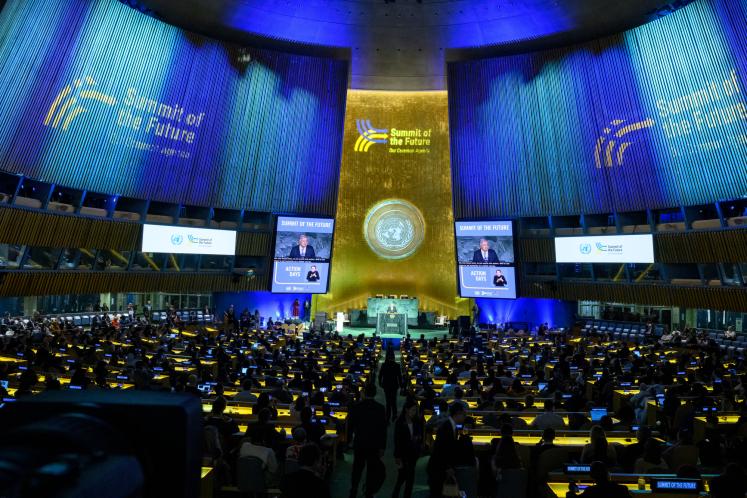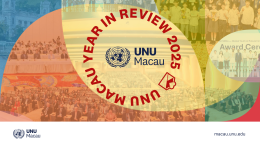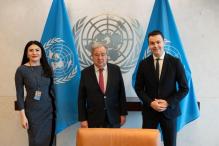The Pact for the Future – an ambitious and comprehensive framework to strengthen international cooperation and revitalize multilateralism – was adopted by the United Nations General Assembly on 23 September at the Summit of the Future.
The Pact outlines actions in five broad areas: sustainable development and financing for development; international peace and security; science, technology and innovation and digital cooperation; youth and future generations; and transforming global governance. It also contains two annexes: the Global Digital Compact and the Declaration on Future Generations.
From peace and security to digital cooperation and the future of global governance, UNU-CPR research has helped shape the Pact’s priority areas.
Acting as secretariat of the Secretary-General’s High-Level Advisory Board on Effective Multilateralism (HLAB), the Centre played a critical role in the development of the HLAB’s advisory report – A Breakthrough for People and Planet.
Commissioned by the Executive Office of the Secretary-General, the report’s recommendations are reflected in many of the actions the Pact for the Future advances. In the lead up to the Summit of the Future, UNU-CPR further developed and promoted these recommendations online and at over 70 international events since the launch of the report – and identified viable implementation pathways that will continue to shape policies, strategies and governance models in the years to come.
Highlights of this work are provided below, aligned with relevant actions included in the Pact for the Future.
Sustainable development and financing for development
Action 4: “We will close the Sustainable Development Goal financing gap in developing countries”.
UNU-CPR input: A report on international financial architecture (IFA) reform, "The demand for a fair international financial architecture", makes the case for an increase in the scale of funding available to ensure Global South countries can meet global climate goals, maintain SDG commitments and address ongoing poverty and development crises.
Action 9: “We will strengthen our actions to address climate change”.
UNU-CPR input: A Thematic Review assessed ways that the UN Secretary-General’s Peacebuilding Fund (PBF) responded to stressors exacerbated by climate change in fragile and conflict-affected environments, including efforts to advance climate adaptation.
Action 9, paragraph 28 (i): “Recognize that adaptation finance will have to be significantly scaled up”.
UNU-CPR input: The IFA reform report is a response to declining investments in development, poverty and climate agendas – contributing to a sense that the IFA is failing and needs a major overhaul. It calls for a drastic increase in the scale of funding available to ensure Global South countries can meet their climate goals.
This thought-piece in World Politics Review considered climate adaptation financing in conflict-affected and fragile states, which tend to be the most vulnerable and least prepared to adapt to climate change, but currently receive the least climate-financing.
Action 10: “We will accelerate our efforts to restore, protect, conserve and sustainably use the environment”.
UNU-CPR input: A Technical Note based on expert interviews and an extensive literature review identified how the HLAB recommendations on elevating the environment in the multilateral system could be taken forward in the context of the Summit of the Future.
International peace and security
Action 13, paragraph 34: “We recognize the interdependence of international peace and security, sustainable development and human rights”.
UNU-CPR input: This 2024 Thematic Review explored 92 projects supported by the Secretary-General’s Peacebuilding Fund (PBF) that investigated synergies between human rights and peacebuilding and uncovered numerous examples of human rights tools and strategies advancing conflict prevention, including addressing root causes and underlying grievances across 55 country contexts.
Action 13, paragraph 34 (a) “Strengthen resilience and comprehensively address the drivers and root causes of armed conflict, violence and instability and their consequences”.
UNU-CPR input: The Thematic Review on synergies between human rights and peacebuilding also included numerous examples of how joint human rights and peacebuilding methodologies can address root causes of conflict, including in the context of ongoing peace and transition efforts in Colombia. Another Thematic Review focused on climate-security and peacebuilding found that investing in environmental peacekeeping approaches, including improvements to agriculture and natural resource management, helped address factors that contribute to persistent conflict and competition over resources.
Action 13, paragraph 34 (b): “Provide equal access to justice, protect civic space and uphold human rights for all”.
UNU-CPR input: The Thematic Review on synergies between human rights and peacebuilding highlighted examples of peacebuilding programming focused on strengthening justice, rule of law and civic space, including a case study in the Democratic Republic of Congo that illustrated how locally vested transitional justice and rule of law activities could contribute to peaceful transitions from peacekeeping operations and ensure a greater likelihood of sustaining peace.
Action 14: “We will protect all civilians in armed conflict”.
UNU-CPR input: A report comprehensively assessed how the efforts of United Nations peace operations to advance human rights contribute to mission effectiveness and broader mission objectives.
Action 18, paragraph 39: “Adequate, predictable and sustained financing for peacebuilding is essential, and we welcome the recent General Assembly decision to increase the resources available to the United Nations Peacebuilding Fund”.
UNU-CPR input: Several Thematic Reviews of the PBF – on climate and natural resources-related programming, human rights and peacebuilding and one forthcoming on youth and peacebuilding – demonstrate the impacts of the PBF and why sustained financing can be critical in many conflict-affected and transitioning countries.
Action 18, paragraph 39 (g): “Address the risks to sustaining peace posed by disinformation, misinformation, hate speech and content inciting harm”.
UNU-CPR input: We investigated how misinformation and disinformation generated by AI technologies impacted on peace and conflict – and identified the measures needed to address their adverse effects. The mechanisms of AI and disinformation are also explored in a policy brief.
A case study from the Thematic Review on human rights and peacebuilding found that efforts to detect and counter hate speech and dis/misinformation were helping to address violence in some contexts – and suggested there was scope to replicate these efforts elsewhere to improve social cohesion, enhance rights empowerment and prevent conflict.
Action 18, paragraph 39 (h): “Pursue stronger alignment between the United Nations, international and regional financial institutions and the needs of Member States affected by armed conflict …”.
UNU-CPR input: A Technical Note provides several recommendations to improve the UN’s Peacebuilding Commission, including a more formal relationship with the World Bank and other international financial institutions.
Action 24: “We will prevent and combat transnational organized crime and related illicit financial flows.”
UNU-CPR input: We surveyed past multilateral efforts to counter transnational organized crime at a global level and considered future directions for a more concerted and effective response, and also developed a case study on MINUSMA in Mali, for a lens on what peace operations can do about these critical conflict drivers.
Action 36: “We will strengthen meaningful youth participation at the national level”.
UNU-CPR input: As part of ongoing research for an upcoming Thematic Review on youth participation in peacebuilding, UNU-CPR researchers visited Guinea to observe youth engaged in developing a national youth action plan and other means of increasing youth participation.
Action 20: “We will accelerate the implementation of our commitments on youth, peace and security.”
UNU-CPR input: The forthcoming Thematic Review on youth and peacebuilding will explore how efforts to encourage youth participation and empowerment have contributed to both local and national political processes and peacebuilding. The Review will also identify examples of youth integration and participation within regional or cross-border initiatives.
Science, technology and innovation and digital cooperation
Action 28: “We will seize the opportunities presented by science, technology and innovation for the benefit of people and planet”.
Global Digital Compact, Objectives 1–4: Closing digital dives, expanding inclusion, fostering safe and secure digital spaces and advancing responsible, equitable and interoperable data governance approaches.
The HLAB report and a series of briefs (available here) advanced the idea of an International Decade for Data to provide a multi-stakeholder, multilevel and multidisciplinary scaffolding to support collaboration in domains of international concern.
A blog considered whether the United Nations’ new International Convention Against Cybercrime could balance law enforcement, privacy and human rights.
Global Digital Compact, Objective 5: "Enhance international governance of Artificial Intelligence for the benefit of humanity".
UNU-CPR input: A Technical Note provides the rationale for a UN-led global governance of Artificial Intelligence (AI); outlines the components of a global AI architecture; and provides recommendations to ensure we can reap the benefits of AI while mitigating its potentially harmful societal impacts.
UNU-CPR also provided critical research support to the UN’s AI Advisory Body, contributing to the Body’s final report. The report offers recommendations and a framework to harness the opportunities of AI – such as opening new areas of scientific enquiry, optimizing energy grids and improving public health and agriculture – while protecting us from its risks and preventing new technologies being captured by a powerful minority.
A blog published by United Nations University Institute for Environment and Human Security demonstrated how despite its risks, AI can be harnessed to navigate and mitigate the effects of the climate crisis and support more sustainable development models. The blog’s ideas are also explored in this video.
Transforming global governance
Action 38: “We will transform global governance and reinvigorate the multilateral system to tackle the challenges and seize the opportunities of today and tomorrow”.
UNU-CPR input: The proposals in the HLAB advisory report advance a vision of international cooperation and global governance that is less hierarchical and more networked, wherein decision-making is distributed and the efforts of a large number of different actors are harnessed towards a collective mission.
Action 41: “We will strengthen the response of the Security Council for the maintenance of international peace and security and its relationship with the General Assembly”.
Action 42: “We will increase our efforts to revitalize the work of the General Assembly”.
UNU-CPR input: "Assembly for Peace" is a user-friendly handbook that offers insights into the General Assembly's past actions on international peace and security, case studies of key interventions and recommendations for fostering stronger collaboration between the General Assembly and the Security Council.
Actions 47–52: Accelerate reform of the international financial architecture – to address challenges; strengthen the voice and representation of developing countries; and mobilize finance for development and climate change.
UNU-CPR input: The IFA reform report offers a critical examination of the Global South’s proposals for international financial architecture reform. The proposals converge on a single overarching ambition: the creation of a more equitable and just international financial architecture.
Specific recommendations include: enhancing representation of the Global South; increasing the speed and agility of international financial institutions; ensuring the scale of financial support matches and addresses the most pressing needs; securing sustainable and affordable financing; fostering global solidarity; and promoting economic self-reliance.
The HLAB advisory report offered tangible recommendations for reforms at the World Bank and IMF, including changes to create more representative leadership, ensuring these institutions reflect a world where developing and emerging markets make up over half of global output.



